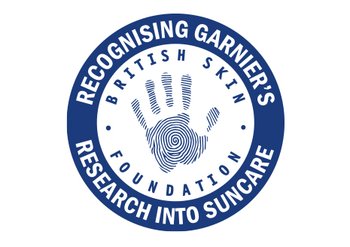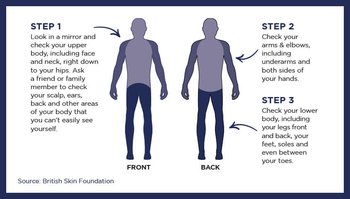
WHY IS CHECKING YOUR MOLES IMPORTANT?
Skin cancer is a common type of cancer and can affect even young people. Thankfully, the majority of cases aren’t life threatening and can be removed easily if they’re detected early.
We are delighted to have teamed up with the British Skin Foundation to share their easy-to-follow advice on how to keep a close eye on your moles, as well as those of your loved ones.

HOW TO CHECK YOUR MOLES
A SIMPLE 3 STEP GUIDE FROM THE BRITISH SKIN FOUNDATION
Do a full body scan, from top to toe, about once a month to check for moles or marks that are changing or new.


WHAT SHOULD YOU LOOK OUT FOR?
In general, the British Skin Foundation recommends looking out for moles or patches of skin that are growing, changing shape, developing new colours, inflamed, bleeding, crusting, red around the edges, particularly itchy, or behaving unusually. If you are worried about any changes on your skin, even if they are not the same as those described here, you should tell your doctor as soon as possible. If in doubt, get it checked out!
There are actually two main types of skin cancers – melanoma and non-melanoma – and these vary in what they look like on skin. More detail on what to look out for specifically for each type of skin cancer can be found below.
MELANOMA SKIN CANCER

.jpg?rev=d03fa4ca78934ffeb7927ac5ef24d4a4)
.jpg?rev=78b4b31c23e149c1a6c3f77487b35d7a)
.jpg?rev=56ffa26631ae4c66999cceb65071a75d)
.jpg?rev=8cf74e8d9e1d431894fbf1d073d15f8b)
NON-MELANOMA SKIN CANCER
Non-melanoma skin cancers can occur on any part of the body. Keep an eye out for:

COMMON RISK FACTORS





At Garnier Ambre Solaire we're committed to helping you and your family protect your skin from the sun.
With over 80 years of expertise in sun protection, it's our duty to help everyone practice sun safety.
HOW TO STAY SAFE IN THE SUN
Here are our tips for staying safe in the sun, whilst still having fun:
- Avoid sun exposure during the times of the day when there is strong sunlight. Spend time in the shade between 11am – 3pm because this is when the UV index is highest.
- Keep babies and very young children out of direct sunlight. Reducing a child’s exposure can decrease the risk of sun damage.
- When choosing a sunscreen, look for both UVA & UVB protection. Choose a high factor of SPF 30+ to protect against UVB.
- Apply plenty of sunscreen around 20-30 minutes before going out in the sun, and reapply every 2 hours and straight after swimming, sweating and towel drying.
- Wear protective clothing such as long sleeves, sunglasses and a broad-brimmed or legionnaires style hat to protect the neck, face and ears.

